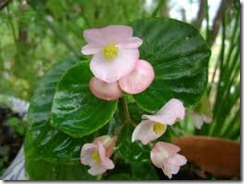There are over 2,000 species of begonias with a wide range of leaf size and color, and with small to enormous blooms covering every color of the rainbow. They are popular for outdoor gardens and a solid choice for indoor pots as they are generally sturdy plants. They provide an array of beauty to those who know how to care for them and how to prevent them from dying.
Know Your Begonias
-
Begonias are basically categorized according to their root type and that is fibrous, rhizomatous or tuberous. Within these three groups, they are further divided into sub-groups according to their leaf size, shape and color, and into their type of bloom and growing requirements.
When you purchase your begonia plant, make sure it comes with planting and growing instructions, and get it from a reputable nursery. While some of them do vary a bit in their instructions, most begonias require the same care. However, this care must be followed almost exactly in order to maintain a healthy plant that produces colorful blooms.
Watering
-
 Watering your begonias
Watering your begoniasIncorrect watering is one of the major reasons that begonia plants die. Indoor begonias should be watered about once a week and outdoor begonias should be watered when the first inch of the soil is dry. If they are overwatered the roots will rot very quickly and the plant will die, and if they are underwatered the roots will dry out and the plant will wither and die.
Make sure the begonias are planted in outdoor gardens or pots that are well-drained. A water meter would be a helpful tool to let you know when the begonias should be watered because it measures the water around the plants. Note that tuberous plants require watering more often than other begonias in order to maintain their enormous blooms. However, you must be careful to not water them before they want it or they’ll die from root rot.
Sufficient Sunlight
-
Flowering begonias require only a couple of hours of sunlight a day and the rest of the time they prefer diffused sunlight. Too much sun causes the plants to dry out too quickly and stunts their growth, and not enough sunlight causes their stems to grow too slowly and to develop fungi.
When begonias are grown indoors and they are in between flowering stages, they should not be in the direct sunlight at all, but rather in a room that has diffused sunlight all the time. Further, begonia plants that are grown for their foliage do not require direct sunlight at all.
Good Soil
-
It is crucial to begonias that they are planted in soil that is rich in nutrients, and that has low pH levels such as can be found in a mixture of heavy soil, peat moss and manure, also known as three-mix potting soil. Make sure you refresh the outdoor gardens each year with a new layer of soil mix and then mix it into the garden. As well, indoor plants should have the first couple of inches of soil removed and replaced about every six months.
Fertilization
-
Begonias should be fertilized regularly to keep the plant healthy, the foliage green and the blooms large and colorful. Avoid chemical fertilizers that are high in salt and that can damage the sensitive roots. A good fertilizer is one that has adequate amounts of nitrogen, phosphorous and potassium, and that is water-soluble for flowering plants.


Deprecated: strpos(): Passing null to parameter #1 ($haystack) of type string is deprecated in /home/agriviek8Qv/agriviet.net/public_html/wp-includes/comment-template.php on line 2522